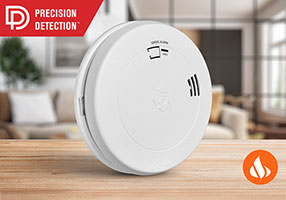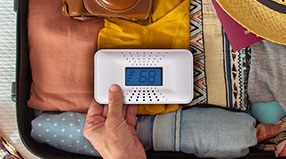First Alert Wireless Interconnect Alarms FAQ
What is a mesh network and how do the First Alert Wireless Interconnect smoke detectors intercommunicate?
First Alert Wireless Interconnect smoke alarms operate on a "mesh network" to integrate smoke alarms for better safety and response in an emergency. All of the First Alert Wireless Interconnect alarms send, receive and resend the initiating alarm's signal. Why is this important? Let's say the signal is blocked from reaching the master bedroom alarm either by distance or some obstruction in the home. With First Alert Wireless Interconnect alarms, the mesh network of alarms re-routes and resends the signal via the other alarms, providing a greater chance all alarms will receive the signal. The "mesh network" is a more reliable means of wireless communication.
How many First Alert Wireless Interconnect alarms can be integrated in a system?
First Alert Wireless Interconnect is a complete integrated wireless smoke alarm and carbon monoxide alarm system. As with hardwired units, the NFPA states that up to 18 total units can be interconnected (RF or hardwired) with a maximum of 12 of those being smoke alarms and the balance carbon monoxide alarms. Take maximum advantage of the flexibility and protection that a First Alert Wireless Interconnect integrated wireless alarm system can provide.
How do the First Alert Wireless Interconnect smoke alarms link with each other?
The First Alert Wireless Interconnect integrated smoke alarm system automatically links through the software using 65,000 security code combinations. This eliminates manual dip switch programming saving confusion and time when installing. With First Alert there is an extremely small chance of a duplicate code being programmed in an adjacent home, ensuring that your wireless integrated smoke alarm system should not receive interference from another system nearby.
How do I program and link First Alert Wireless Interconnect Smoke Detectors?
It is important to follow these steps carefully when programming your First Alert Wireless Interconnect smoke detectors.
TO PROGRAM FIRST ALARM:
- Insert 2 AA batteries. Alarm will say: "Welcome, First Alert Smoke Alarm." It will then say "No location programmed" if this is the first time the device has been activated, or "[Location, example: "Basement"] location programmed" when changing batteries. The detector will then say "To select location, press and hold test button now."
- Press & Hold Test Button if you would like to program the location or change the location of the alarm. Release button after alarm responds. Alarm will say: "To save location, press and hold test button after location is heard." The First Alert Wireless Interconnect smoke detector will list locations.
- After you hear the location of where you are placing the Alarm, Press & Hold the Test Button. Alarm Will Say: "[Location, example: "Basement"] location saved." If no location is chosen: "No location saved." Your Alarm has now been programmed for the location of your choice.
ADDING AND LINKING ADDITIONAL First Alert Wireless Interconnect ALARMS:
Please Note: To create your integrated smoke detector system, steps 1 through 3 below need to be completed within two minutes. If more than two minutes pass, the green power LED will stop blinking.
- Insert the batteries into the battery drawer of the next detector. DO NOT CLOSE THE DRAWER.
- Press and hold the test button and then close the battery drawer.
- Once you hear the unit chirp, release the test button. The green power LED will start to blink indicating the ONELINK detector is waiting for program data from one of the other existing First Alert Wireless Interconnect alarms that are already set up.
Are First Alert Wireless Interconnect alarms listed to ANSI/UL Standards?
Yes. All First Alert Wireless Interconnect alarms are listed by ETL, an accredited nationally recognized testing lab to ANSI/UL 217 standard for smoke alarms and ANSI/UL 2034 standard for carbon monoxide alarms.
Does the First Alert Wireless Interconnect system use photoelectric smoke sensor technology?
The First Alert Wireless Interconnect system uses photoelectric smoke sensors. Photoelectric sensor technology is more nuisance resistant around kitchens and bathrooms, which traditionally are more prone to nuisance alarms from cooking smoke and steam from showers. Some areas of the country require photoelectric alarms near high nuisance areas like kitchens and bathrooms.
How can I silence the First Alert Wireless Interconnect smoke or carbon monoxide alarm?
In all First Alert Wireless Interconnect alarms, there are two silence features: Alarm Silence can quiet nuisance alarms for several minutes. Low Battery Silence can temporarily silence the low battery chirp for up to eight hours before replacing the battery. This is a key feature when the low battery chirp begins in the middle of the night and you do not have any replacement batteries. You can quiet the chirp and then replace the batteries when it's more convenient.
What type of batteries do First Alert Wireless Interconnect alarms use?
Each First Alert Wireless Interconnect alarm requires 2 "AA" batteries. This includes smoke alarms and combination smoke and CO alarms, including the battery operated alarms and the hardwired alarms with battery backup.
What is the length of the First Alert Wireless Interconnect alarm warranty?
All First Alert Wireless Interconnect smoke alarms have a 10-year limited warranty and the combination smoke and carbon monoxide alarms have a 5-year limited warranty.
Are all the First Alert Wireless Interconnect products wireless?
All First Alert Wireless Interconnect products are wireless. However, you will be able to easily hardwire your alarms into your homes electrical system. We offer a Hardwired version of the First Alert Wireless Interconnect system. You can find the hardwired smoke alarm here.
Wireless Interconnected Smoke Alarms


